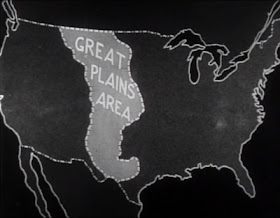
In the midst of another environmental crisis, it's good to recall that this isn't the first time that the American prairie has been in trouble. If it weren't for the inspired music of Virgil Thomson, I probably would not even have heard of the documentary classic, The Plow That Broke the Plains [1936--which can now be viewed in its entirety on YouTube--just click on the title]--if it hadn't been for my interest in the musical suite of the same name that Thomson derived from the programmatic music he wrote for it. The film was sponsored by the U.S. Resettlement Administration to raise awareness about the New Deal, in response to the privations and devastation of the Depression Era Dust Bowl. The entire cost, which the government refused to pay in full, came to about $20,000--a bargain, even in Depression Era dollars! Written and directed by Pare Lorentz, with cinematography by Ralph Steiner, Leo Hurwitz, Paul Strand and Paul Ivano--it's a classic benchmark of social consciousness and environmental awareness in art.

The film may seem crude by contemporary cinematic standards, but it's important to realize that it pre-dates color, and was shot with celluloid film on location with none of the sophisticated editing technology available to producers in later decades. It has a kind of simplistic immediacy which I find charming and more powerful than the sort of slick finish you'd find on a film done today. The honesty of the presentation is probably its chief value, since any commercially backed production would almost certainly have been compromised for content and point of view. There's something charmingly modest and touching about a group of concerned American photographers, a composer, and a enlightened movie director getting together to document a social tragedy, in the hope that it would influence public policy to address outmoded and destructive agricultural practices, and the resulting social chaos it caused (the "Okie" migration documented in, among other places, Steinbeck's The Grapes of Wrath).

Could such a film be made today, about the same kind of crisis which has begun in Texas (the wildfires and drought in the Southwest States)? Doubtful. Too many "special interests" putting too much pressure on Hollywood to imagine that anything like that could be made or released in today's market. The business and corporate industry interests are much more powerful and influential today, than they were in 1936, when this film was released. The American people, who are no longer predominantly an "agricultural" people, probably wouldn't care anyway. Agriculture is today mostly corporate run, and answers to no one, including government.
Instead of the Burma Shave signs which you once saw along American highways, today you're as likely as not to see corporate interests bitching about public water policies caused by urban use, and demanding satisfaction at the public's expense. I know this is true along the roads of California's Central Valley, where corporate agriculture has systematically exhausted the huge aquifer underlying it, and now wants to expand its "take" of the share of water yet "untapped" by building the ecologically disastrous "peripheral canal" around the Sacramento Delta.
If we had an honest documentary film about the devastation in the Delta Country, do you suppose the corporate agricultural interests would have a prayer in conniving to limit the water use by cities? Propaganda is a powerful tool, as the new media players know only too well. Who speaks for the common man today? Fox News?
Ha!
Thank you for this. I look forward to watching the film. Curtis Roberts
ReplyDeleteInteresting.
ReplyDeleteYes, the CV's nearly all corporate ag., excepting a few smaller citrus operations and grape lots up near the foothills. Cotton tho, requires massive lots--and a great deal of H20.
But it still depends on cheap labor--and illegals. Without that the owners cannot make a profit. It's a hellish mess, really, beyond Steinbeck's old tales.
The signs? Often some farmer whining about water, or bureaucrats, or some rapture BS. That, and the small shrines along the roads where some old campesino died in the fields
"(the "Oakie" migration documented in, among other places, Steinbeck's The Grapes of Wrath)."
ReplyDeleteI think that's 'Okie', as in Oklahoma.
"Oakies" are usually squirrels that live in Oak trees.
:-)
SteinbeckSpeak's a bit quaint not to say raw for most Cafe Artistes and poeticals really, Sir F. He wrote about...socio-economic reality (tho it's not sociology per se), not well, hep haikus, or whatever the Edna St Smegma Millay posse at Harriet, etc write about.
ReplyDeleteSteinbeck was not a great visionary ala Joyce or Pynchon but his prose still packs a punch IMHE, notwithstanding the sentimental tone at times (where the merican writer could produce a Of Mice and Men? no where)
That said, as many texans as okies migrated into the south san joaquin--many working in Kern oil fields. And even in Steinbeck's day,there were many hispanic ag workers.
The world Steinbeck described is quite gone now. Checkout Travels With Charley for an update (itself now long out of date). JS had forsaken the comfy fairy tale of pre-War California for the chic backwater of New England by that point.
ReplyDeleteFor a different--and equally poetic--vision of the American Southwest, check out Paul Horgan's early novels, or his non-fiction about early pre-Columbian New Mexico and Arizona. Good stuff.
Could we do without the Edna St. Smegma stuff?--it's unworthy of you.
This comment has been removed by the author.
ReplyDelete